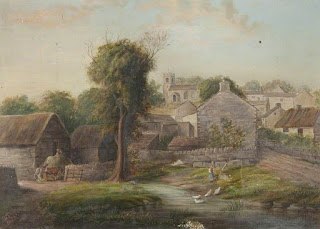Happiness can come in small,
perfectly formed snippets that can be recalled at will many years later. One
such moment for me was the summer having just finished my M. A. on Anthony
Trollope. I had time on my hands, little money but a bedsit in the Uplands area
of Swansea, Joni Mitchell’s Blue album, and three books:
Lavengro
and Romany Rye by George Borrow,
and Rookwood by William Harrison
Ainsworth. Rookwood is worth a post in itself, a baggy, picaresque novel
exploring the C18th underworld, Highwaymen and dissolute
aristocrats. I re-read it many years later and it didn’t disappoint. On that
basis I downloaded a cheap kindle edition of another one his novels: The
Lancashire Witches.
Published in 1849, The Lancashire
Witches is a fictionalised account of the great Pendle Witch trial of 1612. It
also provided ideal material for Ainsworth who was heavily influenced by the
C18th gothic tradition. For some, Ainsworth has been seen as a key
link between the early gothic tradition and the late C19th ‘Penny
Dreadful’ —though the latter connotation does him a disservice. He was quite a
substantial writer, a friend of Dickens and almost as popular.
On finishing the book, two things
struck me:
a) How
‘horror’ has changed and
b) His
attention to detail and the durability of the English countryside.
Ainsworth’s ‘horror’ has more in
common with the medieval morality play and the starkness of old woodcut prints.
Witches range from the dangerously seductive to the more traditional hideous
crone. There are familiars and demons and broomsticks.
It is black and white,
one-dimensional and, I’m tempted to say, lacks psychological depth. But this
wouldn’t be entirely fair, for Ainsworth was writing for an audience that
believed in the eternal struggle between good and evil and the infinite value
of the human soul. The stereotypes of crones and familiars, virtuous and
beautiful young maidens and doomed heroes are time-worn and have less resonance
now, but for a Victorian audience the real horror would have been the
corruption of innocence, the real drama damnation, despair and the hope of
redemption.
With regard to his attention to
detail and the durability of the English countryside, I was struck by the
wonderfully evocative Lancastrian place names, some so evocative I had to check
they actually existed. But places like Whalley Nab exist and remain largely
unchanged since Ainsworth first wrote about them.
Historical figures are also meticulously researched, and
families such as the Asshetons of Whalley and Downham still figure largely in
the area as do their houses.
Painted by Turner, the village of Downham 'nestles' beneath Sir Nicholas Asshton's House adjacent to the Church and just hidden by the trees described in the book.
Whalley Abbey
The Abbey House where Sir Ralph Assheton lived and where much of the action takes place
Whalley Abbey Gatehouse as painted by Turner
The Abbey was bounded by the
towering and well-wooded heights of Whalley Nab. On the side of the Abbey, the
most conspicuous objects were the great north-eastern gateway.
Rough Lee Hall, home of the witch Alice Nutter
For those who enjoy evocative set pieces,
Ainsworth delivers—much in the vein of Sir Walter Scott. His descriptions of an
otter hunt, a stag hunt, and the impact of a royal visit to Houghton Tower
(James I) are powerful and stay in the mind.
Whalley parish church, exterior and interior exactly as Ainsworth describes.
Whalley figures prominently in the
book. One of the witches, Old Chattox is keen to get to one of three Saxon
crosses in the parish churchyard. To the villagers their antiquity and strange
carving render them magical. Their magic is confirmed when Old Chattox
mysteriously vanishes:
“She has rendered herself invisible, by
reciting the magical verses inscribed on that cross.”….
“What strange uncouth characters. I
can make neither head nor tail, unless it be the devil’s tail, of them.”
The crosses are still there for you
to decide, as is the Calder where Nan Redferne was molested and brutally ‘ducked.’
And overshadowing Whalley Nab, the
village and church, Rough Lee, Whalley Abbey and Downham is Pendle Hill itself.
For a view of the surrounding countryside from the top, click here.
For more pictures of the surrounding countryside and in particular the mystery of Malkin's Tower, click here
And for those curious about Jeanette Winterton's book on the Pendle Witches, click here
















4 comments:
So were there actual witch trials in England like there were in America in the 17th century?
PS I never tire of seeing pictures of the English countryside. It's always so green. :)
I sometimes wonder if you Brits don't handle witches and such better than we Yanks. Maybe because your history goes so much deeper.
Maria, there were Witch Trials. In reality the Pendle Witches suffered horrible conditions in Lancaster castle's dungeons before they were hanged. The last witch to be prosecuted was in 1720, Janet Horner if i remember for conjuring a flying horse.
Having said that, a fortune teller was done for revealing D D Secrets during World War II. Put Churchill in a bit of a flap :)
Linda, I'm not too sure we did handle witches that well. All that can be said is that we hung ours instead of burning them alive. I think the last great spate of witch finding was during the C17th during the 'mini ice age' when poor harvests brought diseases and food shortages and of course the bloody Puritans. An unbelievable number of witches were burned in Europe, A smaller number were hanged in Britain, mostly in Puritan areas. 'Do not suffer a witch to live' etc Leviticus or was it Deuteronomy? ,
Post a Comment